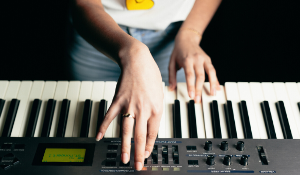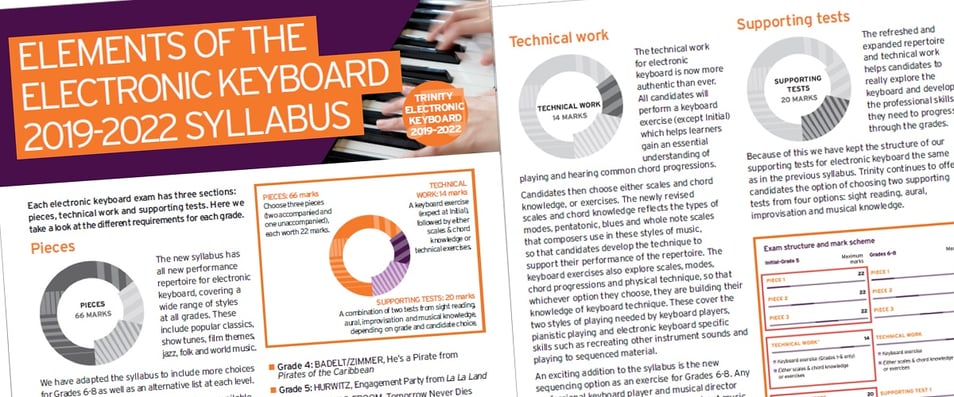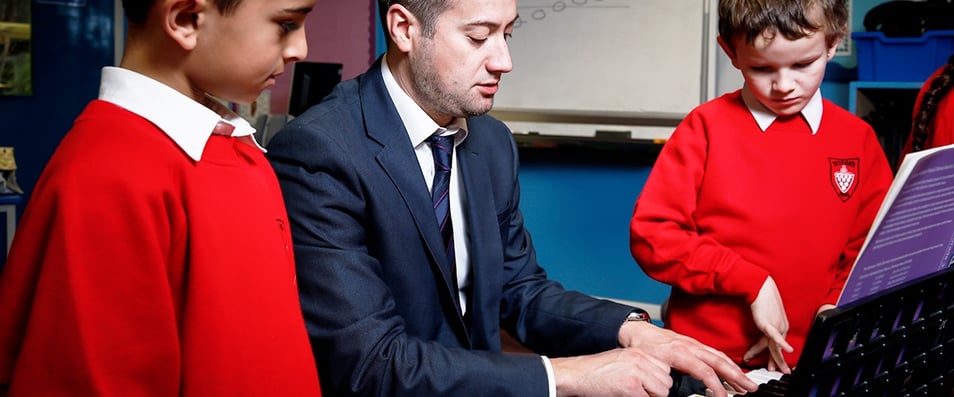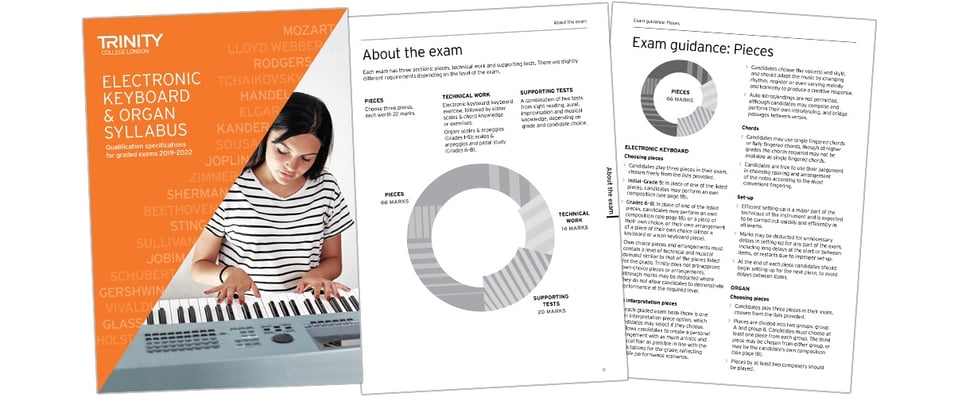New Scales, Arpeggios and Chord Knowledge for Electronic Keyboard

Nikki Franklin takes us through the new scales, arpeggios and chord knowledge for Electronic Keyboard 2019-2022.
As teachers and performers, we are excited to see the new electronic keyboard syllabus coming in 2019, and particularly the changes to the scales and chord knowledge, as scales, modes and chords are the building blocks of many of the pieces you see in the syllabus. The new scales are truly dedicated to the instrument, a bespoke set with clear graded progression that reflect the vocabulary of the working keyboard musician.
A world apart
As electronic keyboard players and teachers, we have a unique identity apart from the piano or organ syllabus. Although many of the skills are common throughout keyboard instruments, we have the opportunity to step into many worlds through one instrument; consider the diversity from ‘French DJ’, exploring Saw tooth and Pop Brass in the Grade 5 ‘Gym Workout’ against whistle and harmonica with a touch of D lydian in the Grade 4 Scottish folk ballad, ‘Highland Laddie’, in turn completely contrasting with pianistic ‘Ballroom Elegance’ at Grade 8, with the lush addition of layered strings as the piece progresses. This addition of strings to piano is frequently used in performance settings as an electronic keyboard player; many of us will be familiar with the strings solo in Ben E. King’s ‘Stand by Me’ as a classic example of this layering.
Modes in action
Modes are often associated with jazz vocabulary, to some, a mystical variation on the standard major and minor key centres. However, folk music has been grounded in the modal system for hundreds of years - in particular the major modes Ionian and Mixolydian, and the minor modes Dorian and Aeolian - and much of the vocabulary of rock and pop is grounded in modal harmony. The contemporary electronic keyboard player is constantly looking for new sounds and ways to develop language in accompaniments, improvisations and compositions. Exploration of the modes through the grades can open a new palette of sounds to students across a breadth of musical styles.
There are many ways to explore modal playing in lessons and performance. Modes are frequently referred to in terms of how ‘light’ or ‘dark’ they are. This refers to the placement of the semitones in the scale. The lightest, Lydian, opens with whole tones, the darkest, Locrian, starts immediately with a semitone ‘crunch’ on the flattened 2nd and has the dominant flattened for that really moody b5 sound.
The word ‘LIMDAPL’ can be used as an acronym to recall the order of modes from light to dark.
- Lydian, used in a major setting, has the most lift, with the #4 (or #11) in the scale. This scale is used by Bjork in the vocal line of her 1995 hit ‘Possibly Maybe’, giving that ethereal lift to the sound. Steve Vai and Frank Zappa were also fans of the Lydian mode – try playing this scale over major 7 chords, or major 7 #11 if you want to be really adventurous!
- Ionian, the classic major scale – think of these in a folk setting, totally diatonic with no accidentals.
- Mixolydian, a major mode with flattened 7th, perfect for use over a dominant 7th chord. This can be used effectively in a blues setting, to explore a wider sound world than falling back on the blues scale all the time.
- Dorian, the first of the minor modes, using flattened 3rd and 7th. These work beautifully over minor7 chords and allow exploration in a minor setting that has a more open sound than the harmonic minor with the raised 7th.
These modes are all covered in the new syllabus. You can also explore the further modes in this system:
- Aoelian, ‘natural minor’ with flattened 3rd, 6th & 7th
- Phrygian Spanish / Latin sounding, with flattened 2nd, 3rd, 6th & 7th
- Locrian, that darkest of the set, with flattened 2nd, 3rd, 5th, 6th & 7th.
Graded Progression
The scales now incorporated into the syllabus make up the building blocks for electronic keyboard players, exploring pentatonics in more detail and with a natural transition from the minor pentatonic scale to the blues scale. This syllabus offers an opportunity for discussion and deeper understanding of the chord/scale relationships in melodic writing, improvising and harmony. Further, the chord progressions are repertoire-led, an improvement on stand-alone chords and cadences from the previous syllabus. Application of the scales and chords will allow the student to demonstrate their technical ability on the instrument whilst recognising and responding to musical features in a practical context.
Foundation (Initial – Grade 3)
Compared with the previous syllabus, the scales are more logical – now based around tonal centres. For example, Grade 1 uses G as a tonal centre, with the major scale (1 sharp) and the dorian scale (1 flat).
We say goodbye to contrary motion scales, rarely used in electronic keyboard performance, and together with the modal scales, we introduce blues scales and pentatonics (major and minor), which also are structured within the same graded tonal centres. The basic chord progressions are intuitive and reflected in the pieces.
Grade 2: Mixolydian Scale on F

Intermediate (Grades 4-5)
- The Lydian scale appears. For example, Grade 4 includes the Lydian scale on Ab, as well as the major scale.
- The new chord progressions are taken directly from contemporary music from the 1950’s to date. In Grade 4, the introduction of the I-VI-IV-V7-I progression is the foundation of more songs than can be mentioned (‘Stand by Me’ being just one example). There are even comedy skits based on the number of songs that use this progression! Learning these chords in all keys will give the electronic keyboard player a ‘toolbox’ of progressions that can be used in performance settings across the world.
Grade 4: Chord progression I-vi-IV-V7-I in E major


- Although there are fewer chords in isolation than the previous syllabus, those listed for the intermediate grades are important featured chords in the more complex harmonic structures of the repertoire at this level.
Advanced (Grades 6-8)
- The arpeggios here are a fantastic development – relating the arpeggio to the scale and chord links the knowledge together and helps the student make the connection between their technical exercises and performance pieces. The arpeggios are performed with the right hand, as is the case in electronic keyboard repertoire, improving dexterity and agility at the instrument.
Grade 7: Dorian scale on G# followed by minor 7th arpeggio


- Use of tonal centres – at an advanced level, the student should be prepared to perform in any key. The syllabus strongly supports this with the introduction of all the keys throughout the grades. This is further established by the chord knowledge in the advanced grades. The progressions in previous grades would be well employed across the new tonal centres.
- Removal of cadences – as above, moving to chord progressions underpins all types of repertoire.
All the new scales, chords and arpeggios are printed in the Electronic Keyboard Exam Pieces & Technical Work books: 2019-2022, complete with fingerings.
As a teacher, I consider the technical requirements for grade exams a snapshot of the knowledge of a student. I personally teach scales, arpeggios and chords in line with the repertoire a student is learning – as useful as tools for fingering patterns, improvisation resources and inspiration for melodic lines and harmonic structure in compositions and own interpretations. When we are preparing for graded exams, it becomes natural to focus on the tonal centres and chord progressions in the syllabus, as these are necessary tools for learning the chosen pieces. The new syllabus supports this holistic approach to teaching, which seems to be employed by many teaching professionals using the electronic keyboard syllabus. Although some tweaking of our own knowledge may be required to embrace new scales and progressions, this is the life of music – a progression itself!
 Nikki Franklin is a pianist, keyboard player and vocalist and has performed as a solo artist and in many bands throughout the UK and Europe. Currently, outside of her examining work for Trinity, she is working as a composer and arranger on her own projects and with commissions from musicians in Italy, France and Poland. She also works as a piano/keyboards and vocal tutor, with over twenty years private and peripatetic teaching experience. Nikki loves her teaching work, particularly one-to-one sessions with a wide age range of students, from beginner to Diploma standard. She is currently in the final stages of a Composition PhD at the University of York.
Nikki Franklin is a pianist, keyboard player and vocalist and has performed as a solo artist and in many bands throughout the UK and Europe. Currently, outside of her examining work for Trinity, she is working as a composer and arranger on her own projects and with commissions from musicians in Italy, France and Poland. She also works as a piano/keyboards and vocal tutor, with over twenty years private and peripatetic teaching experience. Nikki loves her teaching work, particularly one-to-one sessions with a wide age range of students, from beginner to Diploma standard. She is currently in the final stages of a Composition PhD at the University of York.
Nikki has performed in many UK venues, including Ronnie Scotts, the Royal Festival Hall and the Barbican. Her own compositions have been performed at the Royal Albert Hall, The Huddersfield Festival and at Aldeburgh, including works for Large Ensemble (The Spike Orchestra, Tzadik Records) and a large work for jazz orchestra and 2000 voice children’s choir.



